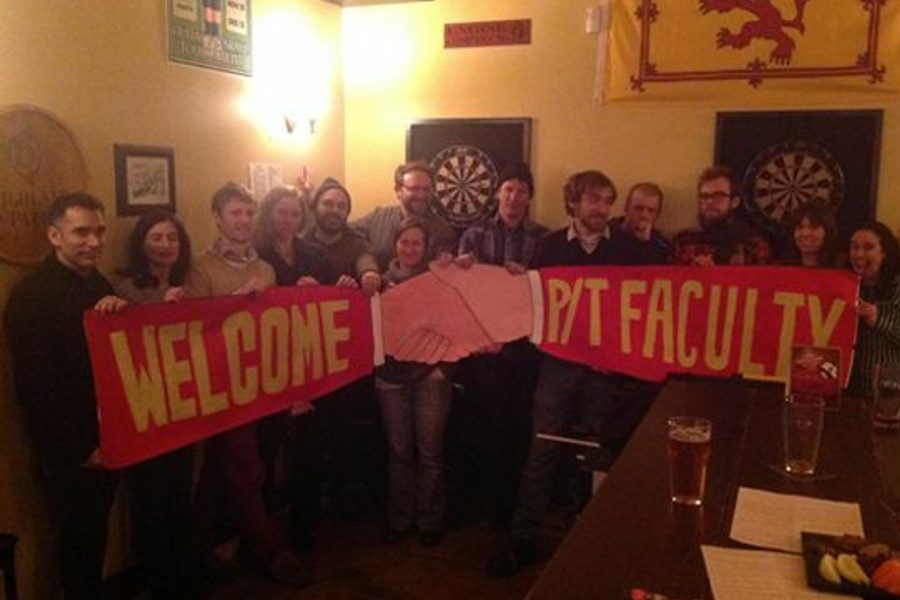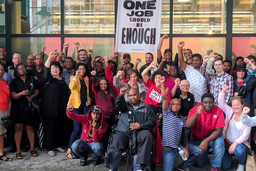
BALTIMORE — Part-time college faculty members at the historic Maryland Institute College of Art (MICA) scored an impressive win on Tuesday when they voted overwhelmingly to bring a labor union on campus for the first time since MICA’s opening in 1826.
In secret ballot voting supervised by the National Labor Relations Board (NLRB), the pro-union votes number 160, compared to 75 anti-union ones, reports Katherine Kavanaugh, one of the leaders of the faculty group. This unofficial count has been confirmed by a NLRB spokeswoman, who adds that the agency normally takes about a week to confirm an election of this kind. Once the election is formally certified by NLRB, the part-time college instructors will be represented by Gaithersburg, Md.-based Service Employees International Union Local 500.
Though the election period itself took only seven weeks, the victory represents a major benchmark in the part-time professors’ sustained campaign to improve job conditions and the overall quality of campus life, says Kavanaugh. The professors, also known as adjuncts, began meeting informally in 2011 to discuss ways to raise pay, provide access to health insurance benefits and ensure job security, she says. Those early meetings developed incrementally into a formal part-time faculty committee, she continues, which itself eventually became the MICA Adjuncts Union.
“This wasn’t at all about unionization when we started,” Kavanaugh tells In These Times. “It was about teachers who felt strongly that change was needed both for the benefit of the adjuncts and for the benefit of the students at MICA. … We wanted to work with the full-time faculty and with the administration.” While the full-time faculty remained neutral, Kavanaugh says, the administration ducked the adjuncts’ attempts to discuss the issues — and that’s what prompted the moves toward formal organization.
“It was only when the administration continued to stall us, when they made it clear they wouldn’t work with us in a serious way, that we started talking about a union,” Kavanaugh says.
The reluctance by administrators to engage with the MICA adjuncts has since continued, adds Joshua Smith, another leader of the adjuncts’ group. The fledgling union had initially hoped that higher-ups, namely MICA President Fred Lazarus IV, would adopt a neutral stance in the union election like the full-time faculty had, he says. As MICA’s president for the last 35 years, Lazarus has earned respect and deference from most instructors and staff — and a relatively positive take on the union from him would have resonated both during and after the election.
To the adjuncts’ disappointment, however, Lazarus came out publicly against organizing last month, inviting part-time faculty to meetings where he lobbied for “no” votes. “The administration wasn’t heavy-handed: Nobody was required to go to the meetings and I don’t think the administration ever crossed the line” of labor law in opposing the union, Smith says. Nevertheless, he continues, Lazarus “made it clear how he felt, and he is a very influential voice.”
Despite the dismay Lazarus’ actions provoked, Smith points out that he is also preparing to retire, suggesting that the entire campus is entering a period of transition. A new president, Samuel Hoi, will take office later this year, and Smith says many adjuncts are hopeful that the change will be a good opportunity to create a more cooperative labor-management atmosphere. (Hoi himself has remained mum on the subject.)
“[Lazarus’] retirement was a really a unique moment” for the formation of the union, Smith remarks, because its imminence provided some cushioning for workers around the president’s push against organizing. “I think that some of the adjuncts felt that they could vote for the union without provoking a confrontation” with Lazarus, he says.
MICA spokesperson Jessica Weglein Goldstein turned down several In These Times requests for an interview with Lazarus or other top MICA officials. Instead, she provided this prepared statement:
We look forward to working with the union that will be representing our part-time faculty and are confident that our adjuncts will continue to join us in making their highest priority the academic and campus experiences of our students.
For SEIU Local 500, the vote marks the latest in a string of union organizing victories for adjuncts at colleges and universities in the region. Last year, the union won an election at Washington, D.C.’s Georgetown University to represent some 650 adjuncts. Another election in 2012 to represent about 700 part-time professors at D.C.’s American University was similarly successful.
Local 500’s organizing efforts are associated with SEIU’s “Adjunct Action” project, which is stimulating union organizing on college campuses in widely scattered sections of the country. Just within the last several weeks, Adjunct Action has been involved in active union election campaigns at Marist College in New York state, Macalester College in Minnesota, and Seattle University in Washington state; all three have yet to be decided.
MICA Adjuncts Union members expect to begin meeting this week to draft out strategy and tactics for negotiating a first contract. Its fundamental goals are those shared by the growing adjuncts’ movement nationwide, Smith reports: Namely, they will strive to improve overall compensation and better integrate the part-time faculty into the traditional college community.







